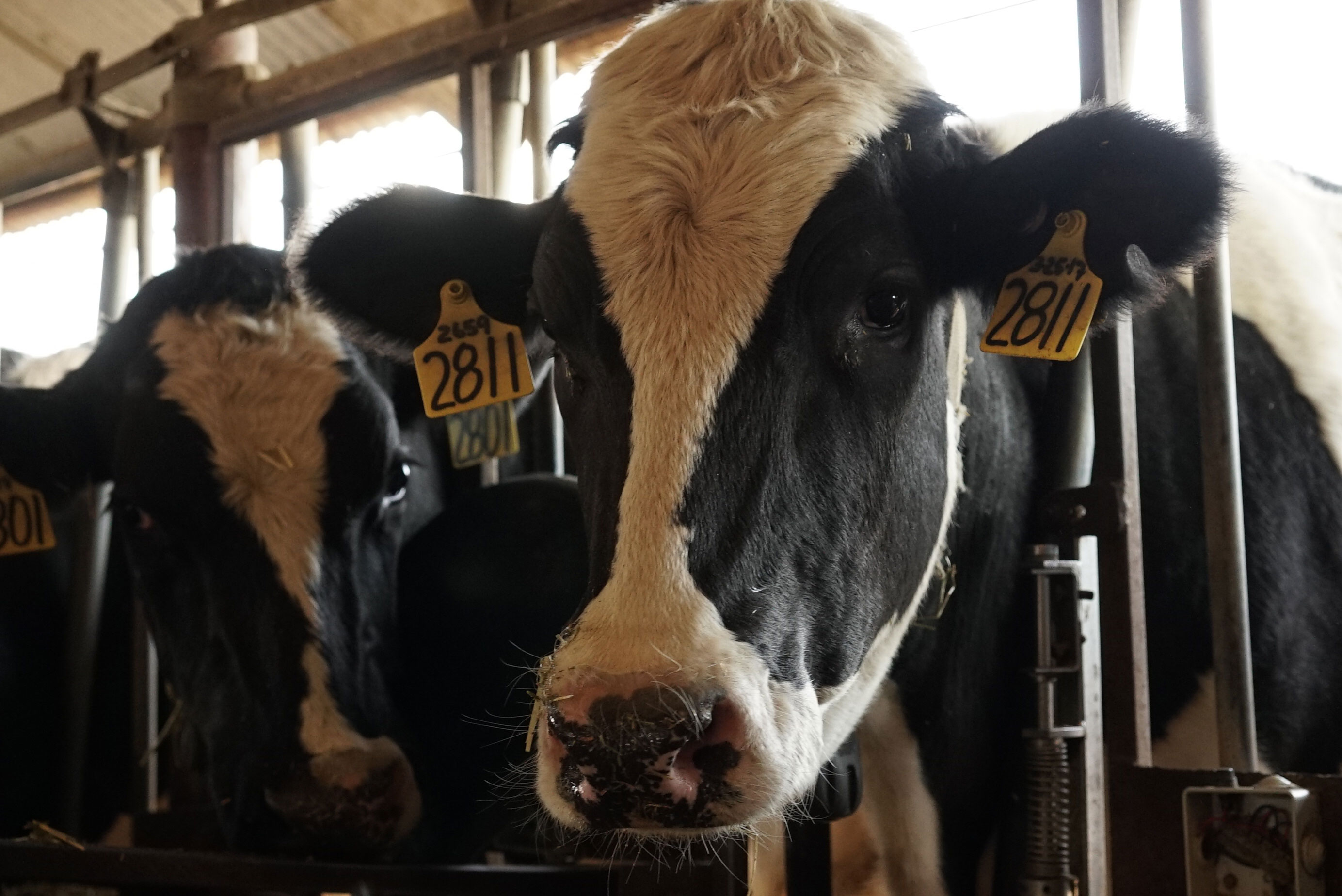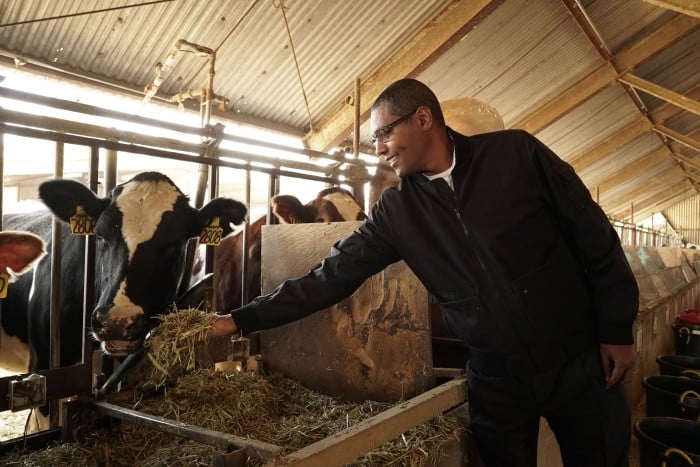Seaweed could make cows burp less methane and cut their carbon hoofprint

In a wooden barn on the edge of campus at the University of California, Davis, cattle line up at their assigned feed slots to snatch mouthfuls of alfalfa hay.
This past spring, several of these Holstein dairy cows participated in a study to test a promising path to reducing methane emissions from livestock, a huge source of the greenhouse gases driving climate change. By adding a small amount of seaweed to the animals’ feed, researchers found, they could cut the cows’ methane production by nearly 60%.
Each year, livestock production pumps out greenhouse gases with the equivalent warming effect of more than 7 gigatons of carbon dioxide, roughly the same global impact as the transportation industry. Nearly 40% of that is produced during digestion: cattle, goats, and sheep belch and pass methane, a highly potent, albeit relatively short-lived, greenhouse gas.
If the reductions achieved in the UC Davis study could be applied across the worldwide livestock industry, it would eliminate nearly 2 gigatons of those emissions annually—about a quarter of United States’ total climate pollution each year.
Ermias Kebreab, an animal science professor at UC Davis who leads the work, is preparing to undertake a more ambitious study in the months ahead, evaluating whether smaller amounts of a more potent form of seaweed can cut methane emissions even further. Meanwhile, some businesses have begun to explore what could be the harder challenge: growing it on a massive scale.
“Very, very high reductions”
The problem is the digestive process of cattle and other ruminants, known as enteric fermentation. Microbes in their digestive tracts break down and extract energy from the carbohydrates in fibrous grasses. But the same process also generates hydrogen, which a separate set of microorganisms feed on, producing methane.
About 95% of the gas escapes through the mouth and nostrils, while the rest exits in the other direction.
Researchers have explored a number of potential paths to lowering livestock emissions, including selective breeding (some animals are less gaseous than others), vaccines, microbiome transfers, various dietary supplements, and more efficient feeds—all with varying results, says Dan Blaustein-Rejto, senior agriculture analyst with the Breakthrough Institute, a research center focusing on technological solutions to environmental problems.
But there’s growing momentum behind the seaweed approach, thanks to almost shockingly effective results in initial scientific studies. In 2014, Australian researchers found that low doses of a red algae known as Asparagopsis taxiformis virtually eliminated methane production in lab experiments. Field trials with live sheep cut emissions as much as 80%, while the UC Davis experiment, the first on live cattle, showed a 58% reduction on average when a related seaweed made up 1% of their diet.
More milk and meat
Kebreab grew up in Eritrea, an East African country on the coast of the Red Sea that struggles with recurrent droughts and famines. The continual shortage of milk or meat inspired him to study livestock, in the hope of finding sustainable ways to produce more of both.

Kebreab first began researching the methane problem more than a decade ago. But the recent work on seaweed was prompted, in part, by California’s passage of a law in 2016 that called for reducing the state’s methane emissions by 40%. That’s placed real pressure on businesses to find effective and affordable ways of doing so, particularly among the Central Valley’s cattle and dairy farmers. The statute focuses primarily on the related but smaller problem of reducing methane from livestock manure—for which there are some available means to make and measure progress. But cutting emissions from cow burps would also count toward meeting that mandate.
“As soon as SB-1383 came online, the interest level increased hugely—and it’s concentrated in California,” Kebreab says.
One negative side effect in the initial UC Davis study is that the cattle did decrease the amount they were consuming each day. That’s a big deal, since the more the cows eat, the more milk or meat they produce. Kebreab suspects the issue was simply taste: seaweed is very salty. The researchers ultimately mixed it with molasses to help the medicine go down.
But crucially, in the initial study, they used a form of seaweed that’s not as potent as the red algae employed in the initial Australian lab experiments. Kebreab intends to use that strain in the follow-up trial, and he believes it could cut more emissions even at a lower dose.
In the months ahead, Kebreab will oversee a six-month experiment with 24 beef cattle. He plans to closely evaluate whether the effect on methane persists at the same level over a longer time period, as well as whether the supplement affects health, weight, and the quality of the meat.
Theoretically, as long as cattle don’t notice the taste (or get used to it), the seaweed should help them put on weight. Blocking methane production should mean that more of the consumed carbohydrates get directed to the task of building tissue. If so, farmers could see an economic return on the up-front cost of this supplement—though it may or may not be the most cost-effective option for packing on weight.
But there’s another concern: how to get the 200 kilograms of red seaweed they need for the study. It has yet to be produced on a commercial scale, and doing so could prove tricky.
Getting to scale
Australis Aquaculture, a producer of ocean-farmed Asian sea bass based in Greenfield, Massachusetts, is attempting to find a way through a research project in Vietnam, dubbed Greener Grazing.
The red algae grows naturally in the wild, but it will take a heavy human hand to produce it at the speed and scale necessary to serve even a fraction of the global livestock industry. And so far, the seaweed has resisted attempts to get it to reproduce, says Josh Goldman, the company’s founder.

Greener Grazing and its collaborators are pursuing several paths to solve the problem. If they crack it, the company will move to the next step of attempting to grow seaweed off the coast of Vietnam. The plants would be placed within the type of plastic tube netting used to grow oysters, and suspended a few feet underwater—just deep enough to be protected from waves, but close enough to the sun for photosynthesis to drive growth.
Meanwhile, DSM, the giant Dutch conglomerate, is working on a synthetic additive for the cows. A paper its researchers coauthored found that a methane inhibitor known as 3-nitrooxypropanol, or 3NOP, cut emissions by 30% in lactating Holsteins. The study noted that milk production wasn’t affected during the 12-week experiment, and as a bonus, the “spared methane energy” helped generate tissue, resulting in higher body weights.
DSM Nutritional Products reportedly hopes to commercialize the animal feed and has already applied for US Food and Drug Administration approval to sell it in the United States.
While the reductions aren’t nearly as dramatic as those seen in the early tests of seaweed, a large company with existing manufacturing plants and distribution channels could potentially scale up production faster and drive down costs further than the aquaculture approach, Kebreab says.
DSM didn’t respond to an inquiry from MIT Technology Review.
Beyond California
Kebreab is collaborating with Joan Salwen, a Stanford fellow who founded Elm Innovations, a social venture working to raise money for seaweed research efforts and collaborate with the livestock industry.
Salwen readily acknowledges that more research needs to be done on the health effects of the seaweed—on livestock and humans alike—and that it’s still unclear whether these strains can be scaled up in an economically feasible way. Moreover, earning returns on the product in a state like California, where farmers face regulatory mandates, will be quite different from selling it in poor parts of the world that also contribute to methane emissions.
But if all goes well, Salwen hopes, early markets fostered by strong climate policies could help expand production and drive down costs elsewhere.
Walking back from the barn, Kebreab mentions that venture capitalists have been visiting the campus to learn more about the research and opportunities. He’s been eager to share, given the amount of investment that would be required to get a red seaweed industry off the ground.
“The more money you have, the quicker we can get it to market,” he says.
But Kebreab himself doesn’t have any entrepreneurial ambitions.
“I just like working with the animals,” he says.
Deep Dive
Climate change and energy
The problem with plug-in hybrids? Their drivers.
Plug-in hybrids are often sold as a transition to EVs, but new data from Europe shows we’re still underestimating the emissions they produce.
Harvard has halted its long-planned atmospheric geoengineering experiment
The decision follows years of controversy and the departure of one of the program’s key researchers.
Why hydrogen is losing the race to power cleaner cars
Batteries are dominating zero-emissions vehicles, and the fuel has better uses elsewhere.
Decarbonizing production of energy is a quick win
Clean technologies, including carbon management platforms, enable the global energy industry to play a crucial role in the transition to net zero.
Stay connected
Get the latest updates from
MIT Technology Review
Discover special offers, top stories, upcoming events, and more.